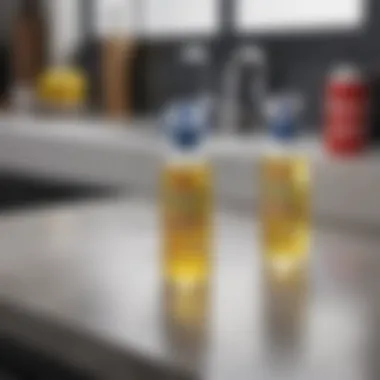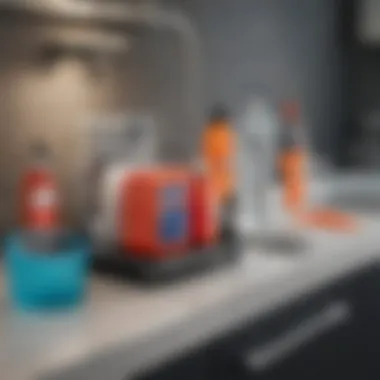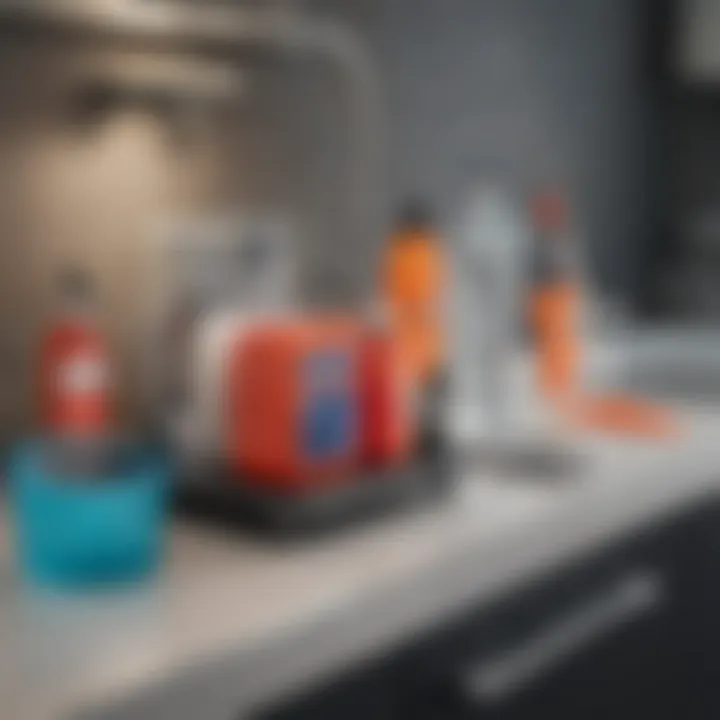Ultimate Guide to Disinfecting All Surfaces Effectively


Intro
In the current landscape, hygiene and cleanliness have taken on heightened significance. Disinfecting surfaces effectively is crucial in maintaining health and safety in various environments. The responsibility of ensuring that our homes, workplaces, and public spaces are free from harmful pathogens cannot be understated. This guide provides a thorough exploration of disinfection methods and practices. By understanding the available disinfectants and learning best application techniques, readers can confidently maintain hygienic spaces.
The focus here will not just be about germs and cleaning products, but also about the role these practices play in enhancing the overall quality of living environments for homeowners, design enthusiasts, and anyone concerned with health. The information presented aims to empower readers to take action and achieve a safer and more aesthetically pleasing atmosphere.
Featured Homes
Disinfection applies uniquely across different types of spaces. For homeowners, understanding how to maintain various surfaces in their residences is vital. As we dive deeper into the subject, we highlight specific architectural and design elements that influence disinfecting practices.
Architectural Highlights
Homes designed with open spaces and high ceilings might accumulate dust and allergens differently compared to small, enclosed areas. Each surface has its own characteristics and requires tailored disinfecting methods. Understanding the materials used in a home’s construction can guide homeowners in selecting appropriate disinfectants. For instance, wood surfaces require a gentler approach than glass or metal.
When considering historical or unique homes, the preservation of architectural features while ensuring cleanliness is paramount. Here, consulting with experts on conservation practices becomes an essential step in maintaining both the structural integrity and hygiene of these spaces.
Interior Design Themes
Interior design extends beyond aesthetics; it plays a role in how easily surfaces can be cleaned and disinfected. For example, minimalist designs with fewer decorative elements may facilitate quicker cleaning. On the other hand, intricate designs may harbor more dirt and require more thorough disinfecting processes.
Using materials that allow for easier cleaning also contributes to maintaining hygiene. Surfaces like granite and quartz can withstand heavy disinfectants without deterioration, unlike more delicate materials which may become damaged.
Closure
Understanding how to disinfect various surfaces takes diligent effort and informed choices. This guide aims to enlighten readers on the methods tailored for different surfaces in diverse environments. By focusing on both health and design, homeowners can create spaces that are both beautiful and safe.
"Maintaining a clean environment is not just a responsibility but also a pursuit of a better quality of life."
When effectively implemented, these practices can significantly reduce the risk of infection and contribute to the overall well-being of all who occupy those spaces.
Preamble to Disinfection
Disinfection plays a vital role in maintaining a safe and healthy environment. In both residential and public spaces, surfaces are frequently exposed to various pathogens. Understanding disinfection is crucial for reducing the risk of infections and disease transmission. This section focuses on defining disinfection and detailing its significance.
Defining Disinfection
Disinfection is a process aimed at eliminating or reducing harmful microorganisms on surfaces. Unlike sanitization, which primarily lowers the number of germs, disinfection seeks to destroy them completely. This process can involve the use of chemical agents, heat, or ultraviolet light.
The Centers for Disease Control and Prevention (CDC) provides guidelines that distinguish between cleaning, sanitizing, and disinfecting. Cleaning removes dirt and debris; sanitizing lowers the number of germs to acceptable levels, while disinfecting eliminates them. Thus, when considering health measures, disinfection emerges as the definitive step necessary for optimal hygiene, particularly in high-traffic areas.
The Importance of Disinfection
Disinfection is paramount in several contexts.
- Health and Safety: Proper disinfection helps prevent the spread of illnesses, especially in places such as schools, hospitals, and offices. Pathogens like the flu virus or bacteria can linger on surfaces, posing a risk to individuals. Regular disinfection minimizes exposure time, lowering infection rates.
- Preventing Outbreaks: Historically, effective disinfection has been critical in managing disease outbreaks. In times of public health crises, such as pandemics, the scrutiny of disinfection practices intensifies. This can lead to the adoption of more effective cleaning protocols in both homes and public areas.
- Environmental Considerations: Disinfection also plays a role in promoting better indoor air quality. Many cleaning agents can produce volatile organic compounds (VOCs) that contribute to poor air quality. Understanding the types of disinfectants and their impacts can help in choosing eco-friendly options.
"Effective disinfection not only ensures a hygienic environment but also builds a culture of health awareness among individuals."
Overall, understanding the definition and importance of disinfection deepens the comprehension of how critical it is to maintain cleanliness in daily life. This sets the stage for exploring the various methods and products available for effective disinfection.
Common Disinfectants Available
Disinfection is a critical step in maintaining hygiene and preventing the spread of pathogens. Various disinfectants are available, each with unique properties and applications. Understanding these options allows individuals to choose the most suitable products based on specific needs and environments. This section discusses two main categories of disinfectants: chemical disinfectants and natural alternatives.
Chemical Disinfectants
Chemical disinfectants are synthetic substances designed to eliminate germs, viruses, and bacteria. They often provide rapid and effective results, making them popular in both domestic and commercial settings.
Bleach
Bleach, or sodium hypochlorite, is widely recognized for its powerful disinfecting properties. It effectively kills a broad spectrum of pathogens, including bacteria and viruses, which contributes significantly to its reputation as a staple in sanitation. A key characteristic of bleach is its strong oxidizing capability. This allows it to break down harmful microorganisms on surfaces. However, bleach should be used with caution due to its toxic nature when inhaled or ingested.
Advantages of bleach include its low cost and high effectiveness, particularly on non-porous surfaces. It also acts quickly, often requiring only a few minutes of contact time to showcase its full disinfection capacity. On the downside, bleach can cause discoloration and damage to fabrics and certain materials, which limits its use in some settings.
Alcohol-based Disinfectants
Alcohol-based disinfectants, primarily composed of isopropyl alcohol or ethanol, are effective against many viruses and bacteria as well. Their key feature is their ability to evaporate quickly, leaving no residue behind. This promotes convenience, especially in fast-paced environments. The versatility of alcohol-based disinfectants makes them a beneficial choice for various surfaces, including electronics and personal items.
One significant benefit of using alcohol is its quick action. It can kill most germs in 30 seconds to a minute if applied correctly. However, alcohol is flammable and should be stored away from heat sources. Additionally, excessive use can lead to skin irritation.
Quaternary Ammonium Compounds
Quaternary ammonium compounds, often referred to as "quats," are another popular category of disinfectants. These products are particularly noted for their long-lasting effects on surfaces. Quats often leave a residual antimicrobial layer that continues to protect against germs even after the initial application.
The major benefit of using quats is their lower toxicity compared to many other chemical disinfectants. They do not emit harmful fumes and are safe for use in various environments. Nonetheless, quats may be less effective against specific pathogens, including some spores.
Natural Alternatives
Natural alternatives to chemical disinfectants are gaining traction for their eco-friendly properties. They often pose fewer health risks while still providing adequate disinfection against many common germs.
Vinegar
Vinegar is a common household item that has gained praise for its mild disinfecting abilities. The acetic acid in vinegar can kill some bacteria and acts as a deodorizer. A noteworthy aspect is its non-toxic nature, making it a popular choice for families with children or pets.
While vinegar can be a beneficial choice for light disinfecting, it may not be effective against all types of pathogens. Therefore, it is best used for general cleaning rather than as a primary disinfectant.
Hydrogen Peroxide
Hydrogen peroxide is noted for its effectiveness as an oxidizing agent. It is capable of killing a wide variety of bacteria, viruses, and fungi. This compound breaks down into water and oxygen over time, making it environmentally friendly. One of its key advantages is that it does not leave any harmful residues behind, which is appealing for food preparation areas.


Despite its advantages, hydrogen peroxide can degrade quickly, especially when exposed to light and heat. It often requires proper storage in dark containers to maintain its effectiveness.
Baking Soda
Baking soda is best known as a gentle cleaner rather than a strong disinfectant. However, its abrasive properties can assist in scrubbing away stains and odors, thereby contributing to overall cleanliness. Its mildly alkaline nature also helps to remove grease and dirt.
While baking soda does not have strong antiseptic properties, it is safe for various surfaces, including food preparation areas. It is a good complement to other disinfectants but should not be solely relied upon for disinfection purposes.
Evaluating Disinfectant Efficacy
Evaluating the efficacy of disinfectants is a vital aspect of this guide. This process directly influences the safety of our environments and effectiveness in combating pathogens. Understanding how and why disinfectants work allows individuals to make informed choices, ensuring not just immediate cleanliness but long-term hygiene as well.
Understanding EPA Registration
The Environmental Protection Agency (EPA) registration is an essential standard for disinfectants used in various settings. This registration indicates that a product has been thoroughly evaluated for effectiveness against specific pathogens. Products that hold EPA registration possess reliability and offer assurance to users about their safety and efficacy.
In this article, recognizing EPA registration is crucial for selecting appropriate disinfectants. Without this registration, the effectiveness claims by manufacturers may lack credibility. Knowing this helps individuals avoid ineffective products, which could jeopardize health by leaving harmful pathogens unaddressed.
Factors Affecting Disinfectant Performance
Contact Time
Contact time refers to the duration that a disinfectant needs to remain wet on the surface in order to effectively eliminate pathogens. This element is a critical aspect of the overall disinfection process. A key characteristic of contact time is that it can vary significantly among different disinfectants. Some may require only a few seconds, while others may need several minutes. Understanding this concept ensures that individuals or cleaning professionals do not unintentionally cut corners, undermining the efficacy of the disinfection process.
The unique feature of contact time is its direct correlation to effectiveness. If a disinfectant evaporates too quickly due to environmental conditions, it will not be effective. This can lead to potential hazards. Therefore, adhering to manufacturer guidelines regarding contact time can be beneficial in securing a clean and safe environment.
Surface Type
Surface type is another key factor that affects disinfectant performance. Different materials can react differently to various disinfectants. For instance, non-porous surfaces, such as glass and metal, might be easier to disinfect effectively compared to porous surfaces like wood or fabric. Each surface may retain or release pathogens in varying rates, affecting the overall disinfection outcomes.
The unique feature of surface type is its influence on how disinfectants perform. Certain compounds may not penetrate deeply into surfaces like wood, hence leaving pathogens unharmed. Recognizing the unique properties of each surface is crucial. This knowledge enables individuals to select appropriate products to maximize efficacy in their specific environments.
Concentration
Concentration refers to the amount of disinfectant in a solution. This attribute directly influences how well a product works against pathogens. A higher concentration may often yield better outcomes in terms of disinfection. However, it is equally critical to follow manufacturer guidelines to avoid damaging surfaces or creating harmful residues.
The key characteristic of concentration is its significant role in disinfectant performance. Products that are too diluted may not be effective, while overly concentrated solutions can lead to surface damage. Hence balanced concentration is necessary. Assessing this factor is paramount when aiming for effective disinfection while maintaining surface integrity.
Proper Disinfection Techniques
Disinfection is a critical practice for maintaining a clean environment. Proper disinfection techniques ensure that harmful pathogens are effectively eliminated from surfaces. This section will cover the importance of being systematic and thorough in the disinfection process. Key considerations include the initial preparation of the area and the various methods for applying disinfectants. These elements are essential for achieving a high level of hygiene.
Preparation of the Area
Clearing Clutter
Clearing clutter from the area is essential prior to disinfecting. Clutter can harbor germs and make it difficult to reach all surfaces. By removing unnecessary items, you can focus on applying disinfectants to the surfaces that matter. This approach promotes a more effective disinfection process.
Its key characteristic is simplicity; removing objects creates a clean workspace. This is a beneficial choice for ensuring that disinfectant has full access to surfaces. The unique feature of clearing clutter includes the reduction of crevices where germs can hide. One downside might be the time needed to organize spaces, but the benefits outweigh these drawbacks.
Initial Cleaning
Initial cleaning is the step that precedes disinfection. It involves removing dirt and organic materials. This step is vital as it prepares the surface for effective disinfectant action. Any remaining dirt can hinder the performance of disinfectants, compromising the disinfection process.
The key characteristic of initial cleaning is thoroughness. A good cleaning removes soil that could contain pathogens. It is a necessary choice for those serious about disinfecting effectively. The act of cleaning first is a unique aspect of maintaining a hygienic environment. However, one disadvantage is that initial cleaning requires additional time and effort.
Effective Application Methods
Wiping
Wiping is a common method for applying disinfectants. It involves using a cloth or disposable wipe that has been soaked in a disinfectant solution. This method is effective for many hard surfaces. Wiping helps ensure that the disinfectant covers the area thoroughly, allowing for adequate contact time.
The key characteristic of wiping is its ease of use. It’s a popular choice because it requires minimal equipment. The unique feature of wiping is the ability to control the amount of disinfectant used. However, there is a disadvantage; it can result in uneven coverage if not done carefully.
Spraying
Spraying involves using a spray bottle to apply disinfectants onto surfaces. This method allows for even distribution across a broader area, making it suitable for larger surfaces. Spraying is effective for disinfecting items that are difficult to wipe.
The key characteristic of spraying is its efficiency. It is a beneficial method for disinfecting large items, such as furniture. A unique feature of spraying is the potential to reach into crevices where dirt resides. A downside is the requirement of a proper protective equipment to prevent inhalation of disinfectants.
Soaking
Soaking refers to immersing items in a disinfectant solution to ensure complete coverage. It is particularly effective for tools or fabrics that can withstand liquids, such as sponges or mop heads. The technique allows for thorough disinfection, reaching areas that might be missed otherwise.
The key characteristic of soaking is the depth of disinfection it offers. It is a popular choice for managing equipment that requires time to fully disinfect. A unique feature of soaking is that it can eliminate stubborn pathogens effectively. However, the major drawback is that it is not practical for everyday surfaces, as it requires additional time of immersion.
Proper disinfection techniques involve attention to detail. The method chosen must fit the surface being disinfected. Each method has its own set of benefits and limitations. Choosing wisely can greatly affect overall cleanliness.
Disinfecting Various Surfaces
Disinfecting various surfaces is essential for maintaining health in both residential and public spaces. It minimizes the risks associated with pathogens that thrive on surfaces we frequently touch. Effective disinfection not only protects individuals from infection but also nourishes a hygienic environment, which is vital for mental and physical well-being. The methods used to disinfect surfaces vary based on the material and location, often requiring tailored approaches.
High-Touch Areas
Doorknobs
[Doorknobs] are a prime example of high-touch surfaces that are often overlooked. Their everyday usage makes them a significant vector for germs. Regular disinfection is crucial. The smooth surfaces of doorknobs make them easy to clean, which is a key advantage. However, different materials, such as brass or chrome, may react differently to specific disinfectants. Care should be taken to avoid using abrasive cleaners that can cause scratches.
Light Switches
[Light Switches] are another high-touch surface, commonly neglected in routine cleaning. They are frequently operated by numerous individuals, increasing the potential for germ spread. The characteristic of light switches is their easy accessibility, making them a practical choice for routine disinfection. A unique aspect is that they often accumulate greasy fingerprints, necessitating a cleaner that can both disinfect and degrease. Not using the right products may leave a residue, posing usability issues.


Remote Controls
[Remote Controls] often go unnoticed in cleaning routines. They can harbor a surprising number of germs due to their frequent handling, especially in shared settings. The small buttons and crevices make them challenging to clean thoroughly. A beneficial aspect of disinfecting remote controls is the significant reduction in the spread of illness. However, caution is necessary to prevent moisture damage. Using wipes specifically designed for electronics can be advantageous here, balancing cleaning with protection.
Kitchen Surfaces
Counters
[Countertops] are perhaps the most critical surface in any kitchen. They are subjected to spills, food preparation, and other activities, making them hotspots for bacteria. The ease of cleaning solid surfaces is a key characteristic, allowing for effective disinfection. Different types of materials, such as granite or laminate, may require distinct disinfecting agents. A disadvantage includes how porous surfaces can retain bacteria if not properly maintained.
Cutting Boards
[Cutting Boards] pose unique challenges in disinfecting processes due to their contact with raw food. They can harbor pathogens if not properly sanitized. The key characteristic is their versatility but also the risk of cross-contamination. A major advantage is the use of separate boards for meat and vegetables, limiting risk. However, wooden boards may require special treatment to avoid damage when disinfecting.
Appliances
[Appliances] like refrigerators and ovens are often neglected but are essential to clean. Frequent disinfection helps maintain hygienic conditions within these spaces. The key characteristic of appliances is that they combine functionality with cleanliness. The unique feature of being used regularly contributes to potential pathogen buildup. Different materials and designs may lead to varying cleaning requirements, making it necessary to adapt techniques to the specific appliance type.
Bathroom Fixtures
Sinks
[Sinks] are crucial for personal hygiene, making them a high-priority area for disinfection. Regular cleaning not only minimizes germs but also maintains cleanliness. The smooth surface is easy to clean but may need special cleaners to tackle soap buildup. A unique feature is the presence of multiple water splashes, which can lead to persistent wetness and thus the growth of mold if not dried properly.
Toilets
[Toilets] represent one of the highest levels of contamination in a household. As a universal bathroom fixture, thorough disinfecting is necessary. The design focuses on preventing leaks and spills, which supports vigilant hygiene practices. One consideration is the chemical used for cleaning; strong disinfectants are necessary for effective sanitation. However, their harshness may create a hazardous environment, which requires balanced usage.
Showers
[Showers] often host mold and mildew due to their moist environments. Regular disinfection can help prevent the development of these fungi, making it critical for health. The characteristic of frequent exposure to water can lead to increased bacterial growth. A unique feature is the complex angles and surfaces that require thorough cleaning. One disadvantage might be that certain disinfection products can degrade materials over time if not used properly.
Electronics Disinfection
Smartphones
[Smartphones] are frequently used and rarely cleaned, presenting a substantial risk for germ transfer. Their portability means they can be exposed to various environments. The touchscreens, characteristic of smartphones, require gentle yet effective cleaning methods. The unique consideration is the screen's sensitivity to moisture and cleaning agents. Disinfecting wipes specifically designed for electronics can mitigate these risks, balancing cleaning and protection.
Tablets
[Tablets] share similar risks with smartphones. Their larger surface area means that they attract more dirt and germs. The characteristic of being used in diverse settings intensifies exposure to pathogens. One beneficial aspect is their durability; with proper cases, they can withstand regular cleaning. However, care needs to be taken against overly abrasive materials that might damage screens.
Laptops
[Laptops] also require careful disinfection due to their use in various locations. The keys and trackpads can harbor significant amounts of bacteria. The easier maintenance and robust designs of modern laptops make them an advantage to clean. Unique features include traditionally sensitive electronics that require specific cleaning techniques to avoid damage. Using microfiber cloths can ensure effective cleaning without risking harm.
Safety Considerations
Understanding the significance of safety considerations in disinfection is crucial to effective disinfecting practices. Proper safety measures protect individuals from potential harm associated with the use and application of disinfectants. This section explores key personal protective equipment (PPE) and proper storage and disposal strategies that ensure the safe usage of disinfection products.
Personal Protective Equipment
Using personal protective equipment minimizes exposure to harmful chemicals present in many disinfectants. Each component plays a specific role in safeguarding health while disinfecting surfaces.
Gloves
Gloves serve as a barrier between the skin and disinfectants. They protect the hands from chemical burns or irritation. Disposable latex and nitrile gloves are among the most popular choices for disinfecting tasks. Their key characteristic is their flexibility and durability, allowing for precise handling while applying disinfectants.
The unique feature of gloves is their ability to prevent direct skin contact with harsh chemicals, which is beneficial in maintaining skin integrity. However, one disadvantage is that gloves can sometimes provide a false sense of security. Users may overlook other safety precautions while wearing them.
Masks
Masks protect the respiratory system from inhaling harmful fumes or aerosols generated during disinfection. N95 respirators and surgical masks are commonly used. The key characteristic of masks lies in their filtration capabilities, effectively blocking pathogens and chemicals from entering the lungs.
The unique feature of masks is their ability to reduce exposure to airborne contaminants. This is particularly important in spaces with limited ventilation. A disadvantage is that improperly fitted masks may not provide the intended protection. Therefore, ensuring proper fit is essential for effectiveness.
Goggles
Goggles shield the eyes from splashes of disinfectants and airborne particles. They are crucial for tasks involving potent chemicals. Polycarbonate goggles are a preferred option, known for their high impact resistance.
The key characteristic of goggles is their full coverage, protecting not only the front of the eyes but also the sides. This is beneficial in avoiding chemical exposure during application. However, a disadvantage is that some goggles may fog up, reducing visibility during use. Regular cleaning and antifog treatments can mitigate this issue.
Storage and Disposal of Disinfectants
Proper storage and disposal of disinfectants form a critical aspect of safety in disinfection practices.
Disinfectants should be stored in their original containers, tightly sealed, and kept out of reach of children and pets. Additionally, they should be stored in a cool and dry environment away from direct sunlight. This ensures that their efficacy is maintained and minimizes risks of accidental contamination.
When disposing of disinfectants, it’s essential to follow local regulations. Many disinfectants can be classified as hazardous waste. Therefore, disposing of them improperly can lead to environmental harm and health hazards. Some common disposal methods include:
- Following label instructions: Many disinfectant products have specific disposal guidelines on their labels.
- Returning to retail stores: Some stores offer take-back programs for unused products.
- Contacting local waste management services: They can provide detailed guidance on proper disposal methods.
Proper storage and disposal of disinfectants not only protects individuals but also safeguards the environment.
The Role of Disinfection in Disease Prevention
Disinfection plays a critical role in disease prevention, particularly in settings where germs can spread rapidly. Understanding the implications of disinfection is vital not only for health professionals but also for ordinary citizens who wish to maintain safe living spaces. Effective disinfecting practices can significantly reduce the likelihood of illness and can be particularly crucial in combating the spread of contagious diseases.
The primary benefit of disinfection is its ability to eliminate pathogenic microorganisms. This process involves removing or killing germs that may be present on surfaces in homes, offices, and public spaces. It is important to understand that not all cleaning methods achieve this. Simple cleaning with soap and water may remove dirt but will not necessarily neutralize pathogens. Thus, employing a proper disinfection protocol can create a stark difference in protecting public health.


The considerations surrounding disinfection include the type of disinfectant used, the surfaces targeted, and the frequency of disinfection. Selecting an effective disinfectant, such as bleach or alcohol-based solutions, is essential. Furthermore, understanding which areas in a space are likely to harbor pathogens, like bathrooms and kitchens, enables targeted efforts. Regular disinfection of these high-touch areas can limit transmission of illnesses, especially in shared environments.
The CDC emphasizes that routine cleaning and disinfection of frequently touched surfaces can help prevent the spread of germs.
Impact on Public Health
The impact of disinfection on public health cannot be overstated. When disinfection protocols are followed, disease transmission rates can decrease significantly. For instance, during outbreaks such as influenza or norovirus, enhanced disinfecting methods can help to control the spread of these viruses. Public health campaigns often highlight the necessity of proper disinfection in schools, healthcare facilities, and elderly care homes where vulnerable populations reside.
Better disinfection practices contribute to not just reducing illness, but also to building community resilience. When individuals take personal responsibility by cleaning and disinfecting their environment, it fosters overall public awareness about hygiene.
Case Studies of Outbreak Management
Examining past outbreaks can provide valuable insights into the role of disinfection in managing health crises. The COVID-19 pandemic is one of the most pertinent examples. Many public health authorities around the world implemented stringent disinfection protocols in hospitals, public transportation systems, and communal areas. Studies from various regions revealed that consistent disinfection of high-contact surfaces led to a notable decline in virus transmission rates.
Another notable case is the norovirus outbreaks that frequently occur in cruise ships. These outbreaks often lead to widespread illness among passengers. Implementing robust disinfection practices has proven essential in controlling these situations. In these cases, both the frequency and type of disinfectants used play a significant role in how quickly an outbreak is contained.
In summary, the role of disinfection in disease prevention is multifaceted. It not only protects individual health but also contributes to the overall well-being of communities. By adopting and spreading effective disinfection practices, we can collectively combat the spread of infections.
Disinfection in Special Environments
Disinfection in special environments is crucial. Certain locations, like healthcare facilities and food preparation areas, demand extra attention due to the presence of vulnerable populations and high contamination risks. In these settings, standard cleaning may not suffice. The emphasis lies in maintaining strict hygiene practices to prevent the spread of pathogens that could lead to severe illnesses.
For instance, healthcare facilities house individuals who may already be ill or immunocompromised. Therefore, rigorous disinfection processes are essential. Food preparation areas require similar diligence. Contaminated surfaces can lead to foodborne illnesses, harming consumers and damaging the reputation of food establishments. Thus, understanding the unique requirements for disinfection in these special environments is key to promoting health and safety.
Healthcare Facilities
Disinfection in healthcare facilities is vital for preventing Healthcare-Associated Infections (HAIs). These infections can occur due to contact with contaminated surfaces or instruments. The high stakes in this environment necessitate the use of hospital-grade disinfectants that effectively kill bacteria, viruses, and fungi.
Implementing a comprehensive disinfection strategy should include:
- Frequent Cleaning: Regular cleaning and disinfection of surfaces such as patient rooms, waiting areas, and restrooms help eliminate pathogens.
- Use of EPA-Registered Disinfectants: Only products registered with the Environmental Protection Agency should be used. These have undergone rigorous testing to ensure their effectiveness.
- Focus on High-Touch Surfaces: Items like bedrails, doorknobs, and medical equipment should receive special attention. These areas harbor many germs due to frequent contact by staff and patients.
The impact of effective disinfection in such settings is significant, often leading to reduced infection rates and improved patient outcomes.
Food Preparation Areas
In food preparation areas, the stakes are equally high. A thorough disinfection plan protects the safety of food products and ultimately, the health of consumers. Contamination can arise from raw produce, meats, and cross-contamination between various surfaces.
Key practices in maintaining hygiene in this environment include:
- Designated Cleaning Schedules: Establishing clear cleaning and disinfecting schedules for all surfaces, including countertops, sinks, and equipment.
- Use of Approved Sanitizers: Only sanitizers recognized by food safety authorities should be used. These products help reduce harmful bacteria on food contact surfaces.
- Training Staff: It is essential that all food handlers understand proper sanitation procedures. Knowledge about safe food handling practices significantly reduces risks.
Proper disinfection in food preparation areas not only ensures compliance with health regulations but also safeguards public health, enhancing customer trust and business integrity.
"In environments like healthcare and food preparation, effective disinfection saves lives and prevents outbreaks."
Ultimately, understanding the distinct disinfection requirements in special environments is key. Proper protocols can dramatically reduce the risk of infections and promote safer, healthier spaces.
Sustainability in Disinfection Practices
Sustainability in disinfection practices is an essential topic that highlights the ongoing need for environmentally friendly solutions in maintaining hygiene. Disinfection is vital, especially in contexts where public health is at stake. However, the methods and products used for this purpose can significantly impact the environment. Making a conscious effort to adopt sustainable practices benefits not only the planet but also personal health and safety. It is important that we consider both effectiveness and environmental impact when choosing disinfectants.
One crucial element of sustainable disinfection is the use of eco-friendly disinfectants. These are typically made from natural ingredients that are less harmful to the environment and human health compared to conventional chemical-based disinfectants. Eco-friendly products can still deliver effective disinfection while reducing toxic residues.
When making the switch to these products, it is beneficial to look for certifications such as the EPA’s Safer Choice label, which indicates that a product is safer for human health and the environment without compromising on performance.
Eco-friendly Disinfectants
Eco-friendly disinfectants are gaining traction, especially as consumers grow more conscious about their environmental footprint. Common natural options include vinegar, hydrogen peroxide, and essential oils, particularly tea tree oil and lavender. These substances possess natural bactericidal and virucidal properties that can be effective in cleaning various surfaces.
- Vinegar: Acetic acid in vinegar provides antimicrobial properties, making it effective against certain bacteria and viruses.
- Hydrogen Peroxide: A strong oxidizer, hydrogen peroxide breaks down cellular structures in bacteria and viruses.
- Essential Oils: Many have robust antiseptic properties. For example, tea tree oil has been studied for its antimicrobial effects.
Like traditional disinfectants, it's critical to understand the correct usage and application methods. Many eco-friendly disinfectants require longer contact times to be effective. This is an important consideration for anyone trying to maintain effective hygiene practices.
Best Practices for Reducing Waste
Reducing waste in disinfection practices is vital for sustainability. Here are some effective strategies:
- Use Reusable Materials: Opt for washable rags or microfiber cloths for cleaning instead of disposable wipes. This reduces landfill waste significantly over time.
- Concentrated Solutions: Consider purchasing concentrated cleaning products. This means less packaging as you only need to dilute a small amount for use.
- Bulk Purchasing: Buying in bulk can minimize the amount of packaging waste produced and reduce costs in the long run.
- Correct Application: Apply the right amount of disinfectant needed. Overusing products only results in more waste and doesn’t necessarily lead to better cleaning.
By implementing these practical steps, one can effectively maintain hygiene while promoting a waste-reduced environment.
Sustainable disinfection practices not only enhance hygiene but also contribute positively to ecological health, demonstrating a unified approach to public safety and environmental responsibility.
Understanding the relevance of sustainability in disinfection provides a path towards healthier living spaces that respect our shared environment. The choices made today regarding disinfectants and their application can shape a more harmonious balance between health needs and ecological preservation.
End and Best Practices
In sum, the act of disinfecting surfaces holds significant relevance in our daily lives. It serves as a cornerstone for maintaining hygiene and safeguarding health in both residential and public environments. The synthesis of the information presented throughout this guide highlights several critical aspects.
Understanding the types of disinfectants, their efficacy, and proper application techniques are essential in ensuring effective disinfection. Factors such as surface material and contamination levels must not be overlooked. Personal safety precautions enhance not only the safety of the person disinfecting but also the overall environment.
Integrating these insights results in a more methodical approach to hygiene.
Recap of Key Points
Here are some essential points to remember:
- Disinfection is necessary to control pathogens and maintain public health.
- Knowledge of various disinfectants, their applications, and efficacy is crucial.
- Effective techniques such as proper cleaning before disinfection significantly improve results.
- The type of surface dictates the choice of disinfectant and method of application.
- Personal protective equipment should not be neglected during the disinfection process.
Final Recommendations
For optimal disinfecting practices, consider the following recommendations:
- Always read and follow the manufacturer’s instructions on disinfectants.
- Prioritize high-touch areas for disinfection, as they are more susceptible to pathogen transfer.
- Establish a regular cleaning and disinfection schedule, particularly in communal areas.
- Use eco-friendly products when possible to support sustainability efforts.
- Ensure proper ventilation when using chemical disinfectants to minimize inhalation risk.
By adhering to these guidelines, individuals can play a proactive role in promoting a safer, healthier living environment.







